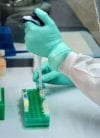Month: May 2020
-
Recapping Current Research Regarding Type 1 Diabetes Development and Cardiovascular Risks
Our bodies are formed from an innumerable number of cells and molecules. Both DNA and RNA play a role in determining cells’ function and purpose. At a conference of the […]
-
Increasing Cell Protection Against Immune System Attacks
One of the challenges researchers have faced with using cell therapy to treat type 1 diabetes is that the body’s immune system may still attack and destroy transplanted cells. This […]
-
Generating Pancreatic Islet Organoids to Treat Type 1 Diabetes
In individuals with type 1 diabetes, the immune system mistakenly attacks and destroys insulin-producing beta cells. Without a naturally occurring supply of insulin to manage glucose, blood-glucose levels can quickly […]
-
Could Insulin-Producing Beta Cells Play a Role in Triggering Onset of Type 1 Diabetes?
Researchers know that type 1 diabetes (T1D) occurs when the immune system mistakenly attacks and destroys insulin-producing beta cells. This leaves the body unable to self-regulate blood glucose levels because […]
-
Redifferentiating Beta Cells to Treat Type 1 Diabetes
All cells serve a specific purpose, and each one plays an integral role in the function and survival of the human body. However, in individuals with type 1 diabetes, insulin-producing […]
-
New Oral Treatment May Help with Managing HbA1c for Type 1 Diabetes
Keeping HbA1c levels within a healthy range can be challenging for those living with type 1 diabetes. It requires constant vigilance when it comes to monitoring blood sugar levels and […]
-
Type 1 Diabetes Cases Continue to Rise
Type 1 diabetes (T1D) is a well-known disease, but it is one that scientists have yet to find a way to prevent or cure. The exact cause is unknown because […]
-
Exploring the Impact of Type 1 Diabetes on Bone Health
The body continually goes through a cycle of bone formation and bone resorption. As bone tissue is broken down and calcium is released, new microstructures are formed to support bone […]








